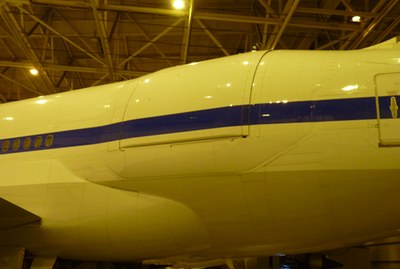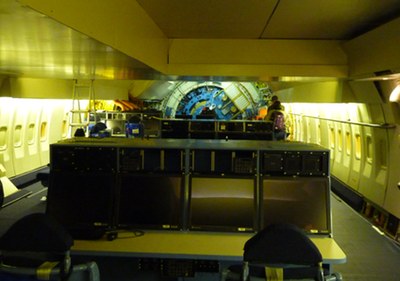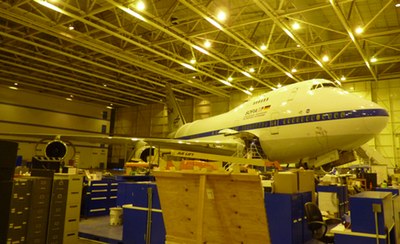An airborne telescope prepares for takeoffby Jeff Foust
|
| SOFIA is one example of a science project that is simple in concept but dauntingly complex in execution. |
On the opposite side of Plant 42 from Site 1 is Site 9, which also belonged originally to Rockwell. Here, from the early 1980s through the mid 1990s, the company built and maintained B-1B bombers. Today, Site 9 serves a very different purpose: it’s the home to NASA’s Dryden Aircraft Operations Facility. The large hangar at Site 9 now houses several aircraft used by the space agency for earth and space science research, from a pair of ER-2 planes (the civilian version of the U-2) to a modified 747 known as the Stratospheric Observatory for Infrared Astronomy, or SOFIA.
“NASA got a sweet deal on the lease of this building” when it moved in late in 2007, said Eddie Zavala, SOFIA program manager, during a tour of the hangar earlier this month. (Prior to NASA moving in, he said, the hangar had been used as a soundstage for several films, including The Terminal and one of the installments in the Pirates of the Caribbean series.) “We’ll be in this building for the life of the program, and SOFIA’s lifecycle is estimated to be 20 years.” And that lifecycle, as measured by the beginning of regular science operations, is finally getting underway.
SOFIA is one example of a science project that is simple in concept but dauntingly complex in execution. Ground-based infrared astronomy is hampered by the presence of atmospheric constituents, particularly water vapor, that absorb infrared light. Putting the telescope in space avoids that problem, of course, but an alternative that is nearly as effective as, but less expensive and more flexible than, a spacecraft is to mount a telescope in an aircraft that flies in the stratosphere, above most atmospheric water vapor. NASA has demonstrated this approach with several aircraft, most notably the Kuiper Airborne Observatory (KAO), a converted C-141 cargo plane with a 91-centimeter (36-inch) telescope that operated from the mid 1970s to the mid 1990s.
 The SOFIA telescope is located behind this door in the aft portion of the 747. (credit: J. Foust) |
As far back as the 1980s, NASA was looking to build upon the capabilities of the KAO by developing an airborne observatory with a larger telescope. The concept that emerged from those mid-1980s studies was close to what SOFIA is today: a 747SP—a model of the 747 with a shortened fuselage; the SP stands for “Special Performance” as the shorter fuselage gave it a longer range—carrying a 2.5-meter telescope provided by Germany, who is a partner with NASA on the program.
Going from those concepts to a flying observatory took longer than most expected, though. Some of those issues were technical, including the structural and aerodynamic challenges of modifying a 747 by cutting a large hole in the fuselage for the telescope and installing a door over it. Others were programmatic: budget problems on both sides of the Atlantic and issues with contractors (United Airlines, who originally was going to operate the aircraft, dropped out after going through Chapter 11 bankruptcy protection in the early 2000s.) In 2006, NASA threatened SOFIA with cancellation because of cost overruns and schedule delays, but reinstated the mission after an agency review found “no insurmountable technical or programmatic challenges” with it.
| “The upcoming year, 2013, is going to be a key transformation for SOFIA,” Zavala said. “We’re going to be transitioning from a development phase to an operations phase.” |
Those problems are now largely behind SOFIA. In 2011, SOFIA went through an “early science” phase, in essence a shakedown cruise for the aircraft, telescope, and instruments. “The early science phase served two primary objectives. The first was to demonstrate SOFIA as a bona fide observatory capable of doing science,” Zavala said at a SOFIA town hall meeting held during the 221st meeting of the American Astronomical Society in Long Beach, California, earlier this month. “We were very pleased with the performance of the observatory in that phase.”
The other purpose of the early science phase, he said, was to provide “critical information” on how to improve SOFIA. “We exercised the system and we identified key improvements that have been the focus of our efforts over the last year,” he said. That work, program scientist Pamela Marcum said later at the town hall meeting, including work to improve the pointing accuracy of the telescope and cleaning of the telescope’s mirrors. The aircraft itself underwent upgrades in the last year, such as the installation of a modern “glass cockpit,” replacing the original analog instruments with computer displays. “It will make the pilots much more efficient in holding to the flight path,” she explained.
Those upgrades are now nearly complete, and Zavala and others said SOFIA will soon begin routine science observations. “The upcoming year, 2013, is going to be a key transformation for SOFIA,” Zavala said. “We’re going to be transitioning from a development phase to an operations phase.”
 The view from inside SOFIA, looking back over science consoles towards the instrument mount and aft bulkhead (in blue), behind which is the telescope itself. (credit: J. Foust) |
The first round of routine science observations, called Cycle 1, is slated to begin this spring, after the completion of checkout flights of the aircraft and commissioning of SOFIA’s four instruments. While most of those flights will be based out of Palmdale, the program plans a “deployment” of the observatory to New Zealand in July to allow for observations of objects visible only in the southern hemisphere.
By the end of the year, Zavala said, SOFIA will demonstrate its full operational capacity, with four flights per week. About 300 hours of observing time is planned for 2013, according to SOFIA science mission operations director Erick Young, with 200 hours allocated to US astronomers and 40 to German astronomers; instrument teams will use the rest. That figure will increase to 400 hours in 2014 for Cycle 2, he said, although the observatory will be offline for part of the year in order to perform “heavy maintenance” on the aircraft. Ultimately astronomers hope to get 1,000 science hours a year on SOFIA.
| “SOFIA will be one of the primary facilities for far-infrared, sub-millimeter astronomy for many years,” Becklin said. |
SOFIA officials said they were pleased by observatory’s performance in its early science phase, noting that about 30 papers have been published so far from data collected during those flights, including in special sections of Astrophysical Journal Letters and Astronomy & Astrophysics last year. As regular use of the observatory ramps up, the program is planning a science conference in the San Francisco Bay Area (science operations of SOFIA are handled by NASA’s Ames Research Center there) in mid-2014.
In Palmdale, the SOFIA team is also getting ready for regular operations. The former B-1 hangar is home not just to the aircraft itself, but also labs where the observatory’s instruments are tested and prepared for flight. In addition, the hangar has a facility for recoating the telescope’s mirror, although the early science flights indicated the mirror may not need to be recoated as often as previously thought.
Inside SOFIA, the aircraft has a Spartan appearance that bears little resemblance to the plane’s past life as an airliner for United and Pan Am. (One item was retained: its name, Clipper Lindbergh, originally assigned to the plane by Pan Am when it took delivery of the plane on the 50th anniversary of Charles Lindbergh’s famous trans-Atlantic flight.) Astronomers sit at consoles, facing aft towards the instrument mount and, behind a bulkhead, the telescope. In the forward section of the cabin are seats for teachers who participate on flights through the program’s “Airborne Astronomy Ambassadors” outreach program.
A typical SOFIA flight will last ten hours, with eight of them devoted to observations. That requires careful planning of the aircraft’s flight path to make sure it’s pointed in the right direction for observations, as the telescope itself can’t rotate like a conventional ground-based observatory. On the other hand, SOFIA has the flexibility to go where needed to perform science, which is particularly useful for observing stellar occultations, when a solar system object passes in front of a distant star. KAO had the same capability, and observations by it helped astronomers discover the rings of Uranus in 1977 and Pluto’s atmosphere in 1988.
SOFIA performed one such occultation observation, flying out over the central Pacific to observe an occultation by Pluto in June 2011. Eric Becklin, chief science advisor for SOFIA, noted at the town hall meeting that SOFIA’s pilots were able to adjust the plane’s flight path during that flight to take into account last-minute observations, putting SOFIA within 100 kilometers of the center of the path of the occultation. SOFIA plans to observe another Pluto occultation later this year, he said.
“SOFIA will be one of the primary facilities for far-infrared, sub-millimeter astronomy for many years,” Becklin said. And the skies above Plant 42, transited in the past by exotic military aircraft, will soon regularly feature a unique 747 seeking to understand the mysteries of the universe.
